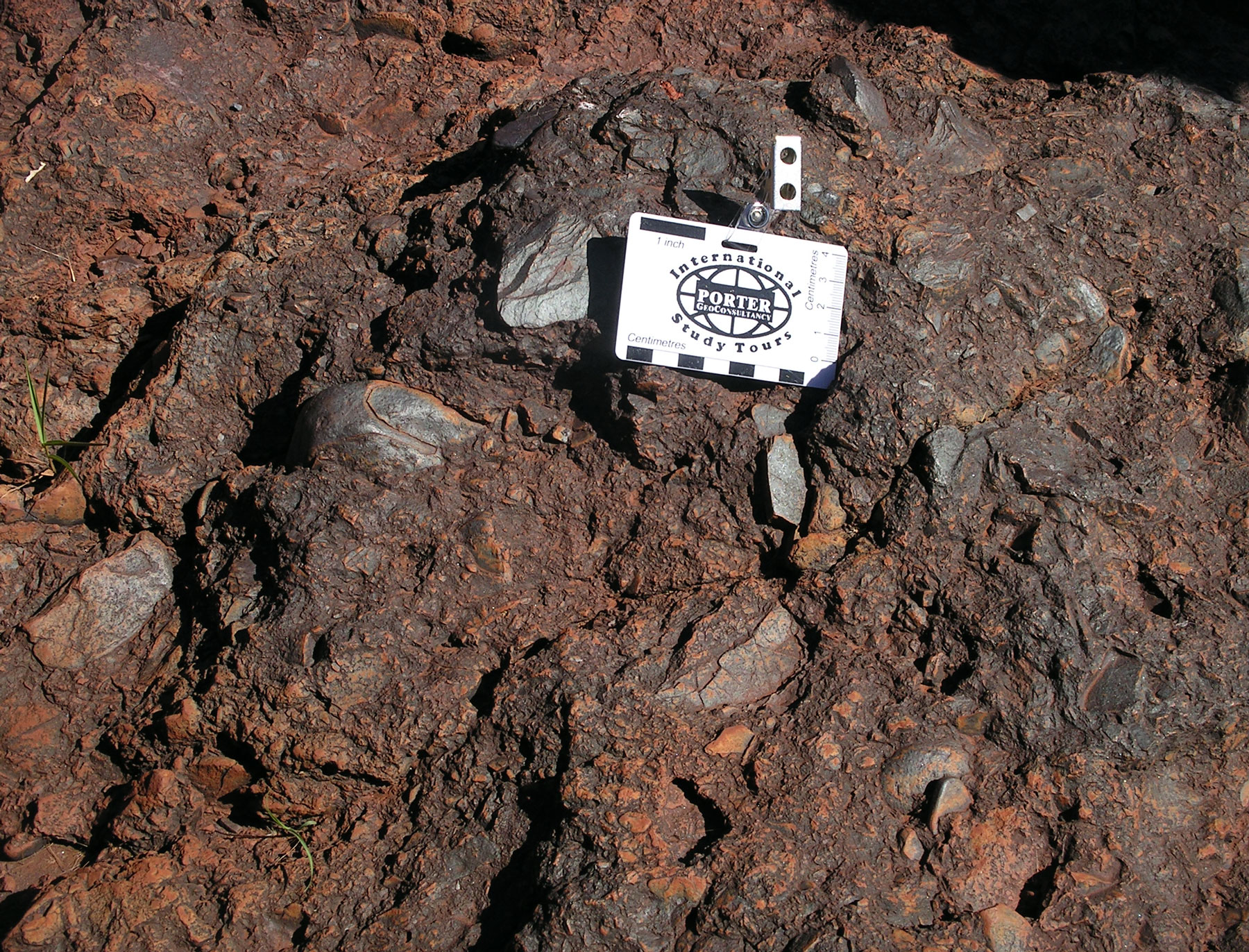Expert Classroom Workshop - The Geology & Iron Deposits of Southern Africa
This workshop, which was held in Johannesburg as the first event of the Iron 2010 International Study Tour, was led by internationally renowned expert Professor Nic Beukes of the University of Johannesburg, and included coverage of the following topics (as known and applicable in April 2010):
• An overview of the geological and tectonic framework of iron ore mineralisation in Southern Africa, and geological controls and distribution of significant iron deposits within the same region.
• The factors influencing the development of ore grade iron mineralisation in southern Africa and the genesis of the key deposits.
• Descriptions of other significant deposits not to be visited and a comparison with those that are on the itinerary.


Ore from the Khumani mine, south of Sishen. Left: High grade laminated hematitic ore of the Manganore iron formation, similar to that at Sishen, and Right: conglomerate ore of the Doornfontein Conglomerate member at the base of the Gamagara formation. Images by Mike Porter, 2010.
In 2010, South Africa was Africa's leading iron ore producer, with an annual output of around 33 Mt, and 'reserves' of approximately 9 billion tonnes, 45% of which are located in the Northern Cape Province. Production comes from two main areas, the Sishen mine in the Northern Cape Province, accounting for over 24 Mt of high grade 65% Fe ore per annum, and the Thabazimbi Mine in the Northern Province. Thabazimbi generally provides iron to South African domestic smelters at Vanderbijlpark and Newcastle, at a rate of around 2 Mtpa, while almost all production from Sishen is exported through the port of Saldanha north of Cape Town. Other iron mines include Khumani and Beeshoek, both in the Sishen area.
Although 700 km apart, Thabazimbi and Sishen are both developed on iron formations in the Palaeoproterozoic Transvaal Sequence, which was deposited between sometime after 2400 Ma and 2100 Ma within an intracratonic basin on the Kaapvaal Craton. The Kaapvaal Craton comprises a 3.4 to 2.8 Ga granite-greenstone basement, similar to the Zimbabwe Craton to the north which is separated by the 2.5 to 2.0 Ga Limpopo Mobile Belt. The granite-greenstone basement terrane is overlain by a series of intracratonic basins, the axes of which migrated north with time from the early 'upper' Archaean to the late Palaeoproterozoic Waterberg System to the north.
The oldest of these, the Pongola System is a 10 000 m thick, ~3.0 Ga succession comprising a lower basaltic volcanic and lesser quartzite sequence overlain by alternating argillaceous and arenaceous sediments with intercalations of BIF. The overlapping ~9 000 m thick Witwatersrand Supergroup was deposited at between 3075 and 2715 Ma, commencing with early Dominion basaltic lavas, followed by a succession of mainly sandstones and shales with lesser locally gold bearing conglomerates. These were, in turn, followed by the up to 5000 m thick Ventersdorp Supergroup composed dominantly of basaltic volcanics dated at 2714 Ma.
The up to 12 000 m thick Transvaal Sequence was deposited unconformably on the Ventersdorp Sequence, and occurs in two connected depo-centres, the Transvaal and Griqualand West sub-basins, which define a 1100 x 350 km, NE-SW elongated area of remaining exposure. This sequence originally covered an area of ~500 000 sq. km.
In the Transvaal sub-basin, the Transvaal sequence commences with the up to 2000 m thick Wolkberg (or Buffalo Springs) Group of valley fill basalts and coarse clastics and lesser argillites. These are followed by the few tens to 500 m thick Black Reef Quartzite, which grades up into the ~3000 m thick Chuniespoort Group which comprises the lower up to 2000 m thick Malmani Dolomite, variably composed of dolostone and chert, and the overlying up to 600 m thick Penge Iron Formation.
The Penge Iron Formation is the host to the Thabazimbi iron deposit and is composed of alternating carbonaceous shale and macro-, meso- and micro-banded BIF (quartz- magnetite- hematite- stilpnomelane- riebeckite- minnesotaite- grunerite and ferriferous carbonates). The uppermost member of the Chuniespoort Group is represented by the dolomites, quartzites and shale of the locally preserved Duitschland Formation. The Chuniespoort Group is unconformably overlain by the 7000 m thickness of quartzites, shales and minor basalts of the Pretoria Group and the 2-3000 m of rhyolitic lavas that make up the ~2100 Ma Rooiberg Group.
In the Griqualand West sub-basin, the Transvaal Sequence is represented by the Ghaap Group, which is unconformably overlain by the Postmasburg Group. The Ghaap Group is sub-divided into the lower interbedded silici-clastics and carbonates of the Schmidtsdrif Subgroup followed by the limestones and dolomites of the Campbellrand Subgroup. These are overlain by the Asbesheuwels Subgroup which is sub-divided into the lower Kuruman Iron Formation, composed of interlayered carbonaceous shale and a chert- carbonate- stilpnomelane- magnetite- hematite- greenalite- siderite iron formation, and the upper Griquatown Iron Formation, comprising siderite-hematite and siderite-greenalite lutites. The Asbesheuwels Subgroup is host to the giant Sishen iron deposit. The Ghaap Group is unconformably overlain by the Postmasburg Group, commencing with the thin Makganyene Diamictite, the thick Ongeluk basaltic pillow lavas, followed in turn by the jasper, banded iron formation and sedimentary manganese deposits of the Hotazel Formation, and finally the Mooidraai Dolomite.
The Transvaal Sequence is unconformably overlain by the shales and red-bed sandstones of the Gamagara Formation, the basal member of the post-2000 Ma Olifantshoek Supergroup. Tha latter sequence is interpreted to be an erosional remnant of the extensive red-bed successions that developed on the Kaapvaal
Craton and its margins during the Palaeoproterozoic, including the extensive thick arkosic arenites of the 2000 to 1700 Ma Waterberg Group further to the east.
PorterGeo Home
| More on This Tour
| Other Tours
| Contact us
This tour was designed, developed, organised, managed and escorted by
T M (Mike) Porter of Porter GeoConsultancy Pty Ltd.
|